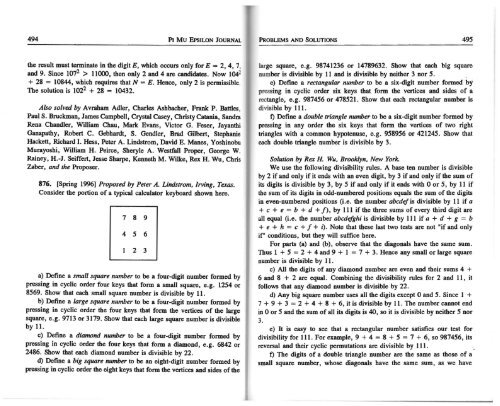Vol. 10 No 6 - Pi Mu Epsilon
Vol. 10 No 6 - Pi Mu Epsilon
Vol. 10 No 6 - Pi Mu Epsilon
- No tags were found...
You also want an ePaper? Increase the reach of your titles
YUMPU automatically turns print PDFs into web optimized ePapers that Google loves.
494 PI MU EPSILON JOURNAL<br />
PROBLEMS AND SOLUTIONS 495<br />
the result must terminate in the digit E, which occurs only forE= 2, 4, 7,<br />
and 9. Since <strong>10</strong>7 2 > 1<strong>10</strong>00, then only 2 and 4 are candidates. <strong>No</strong>w <strong>10</strong>42<br />
+ 28 = <strong>10</strong>844, which requires that N = E. Hence, only 2 is permissible.<br />
The solution is <strong>10</strong>2 2 + 28 = <strong>10</strong>432.<br />
Also solved by Avraham Adler, Charles Ashbacher, Frank P. Battles,<br />
PaulS. Bruckman, James Campbell, Crystal Casey, Christy Catania, Sandra<br />
Rena Chandler, William Chau, Mark Evans, Victor G. Feser, Jayanthi<br />
Ganapathy, Robert C. Gebhardt, S. Gendler, Brad Gilbert, Stephanie<br />
Hackett, Richard I. Hess, Peter A. Lindstrom, David E. Manes, Yoshinobu<br />
<strong>Mu</strong>rayoshi, William H. Peirce, Sheryle A. Westfall Proper, George W.<br />
Rainey, H.-J. Seiffert, Jesse Sharpe, Kenneth M. Wilke, Rex H. Wu, Chris<br />
Zaber, and the Proposer.<br />
876. [Spring 1996] Proposed by Peter A. Lindstrom, Irving, Texas.<br />
Consider the portion of a typical calculator keyboard shown here.<br />
7 8 9<br />
4 5 6<br />
1 2 3<br />
a) Define a small square number to be a four-digit number formed by<br />
pressing in cyclic order four keys that form a small square, e.g. 1254 or<br />
8569. Show that each small square number is divisible by 11.<br />
b) Define a large square number to be a four-digit number formed by<br />
pressing in cyclic order the four keys that form the vertices of the large<br />
square, e.g. 9713 or 3179. Show that each large square number is divisible<br />
by 11.<br />
c) Define a diamond number to be a four-digit number formed by<br />
pressing in cyclic order the four keys that form a diamond, e.g. 6842 or<br />
2486. Show that each diamond number is divisible by 22.<br />
d) Define a big square number to be an eight-digit number formed by<br />
pressing in cyclic order the eight keys that form the vertices and sides of the<br />
large square, e.g. 98741236 or 14789632. Show that each big square<br />
number is divisible by II and is divisible by neither 3 nor 5.<br />
e) Define a rectangular number to be a six-digit number formed by<br />
pressing in cyclic order six keys that form the vertices and sides of a<br />
rectangle, e.g. 987456 or 478521. Show that each rectangular number is<br />
divisible by 111.<br />
f) Define a double triangle number to be a six-digit number formed by<br />
pressing in any order the six keys that form the vertices of two right<br />
triangles with a common hypotenuse, e.g. 958956 or 421245. Show that<br />
each double triangle number is divisible by 3.<br />
Solution by Rex H. Wu, Brooklyn, New York.<br />
We use the following divisibility rules. A base ten number is divisible<br />
by 2 if and only if it ends with an even digit, by 3 if and only if the sum of<br />
its digits is divisible by 3, by 5 if and only if it ends with 0 or 5, by II if<br />
the sum of its digits in odd-numbered positions equals the sum of the digits<br />
in even-numbered positions (i.e. the number abcdef is divisible by 11 if a<br />
+ c + e = b + d + /}, by Ill if the three sums of every third digit are<br />
all equal (i.e. the number abcdefghi is divisible by Ill if a + d + g = b<br />
+ e + h = c + f + l). <strong>No</strong>te that these last two tests are not "if and only<br />
if' conditions, but they will suffice here.<br />
For parts (a) and (b), observe that the diagonals have the same sum.<br />
Thus 1 + 5 = 2 + 4 and 9 + 1 = 7 + 3. Hence any small or large square<br />
number is divisible by II.<br />
c) All the digits of any diamond number are even and their sums 4 +<br />
6 and 8 + 2 are equal. Combining the divisibility rules for 2 and II , it<br />
follows that any diamond number is divisible by 22.<br />
d) Any big square number uses all the digits except 0 and 5. Since 1 +<br />
7 + 9 + 3 = 2 + 4 + 8 + 6, it is divisible by II. The number cannot end<br />
in 0 or 5 and the sum of all its digits is 40, so it is divisible by neither 5 nor<br />
3.<br />
e) It is easy to see that a rectangular number satisfies our test for<br />
divisibility for Ill. For example, 9 + 4 = 8 + 5 = 7 + 6, so 987456, its<br />
reversal and their cyclic permutations are divisible by Ill.<br />
f) The digits of a double triangle number are the same as those of a<br />
small square number, whose diagonals have the same sum, as we have<br />
.•
















